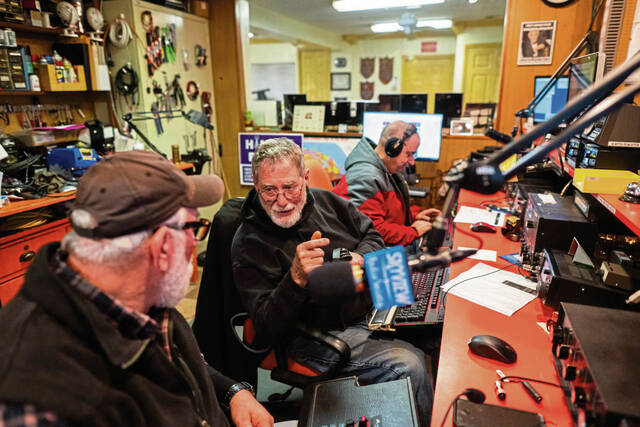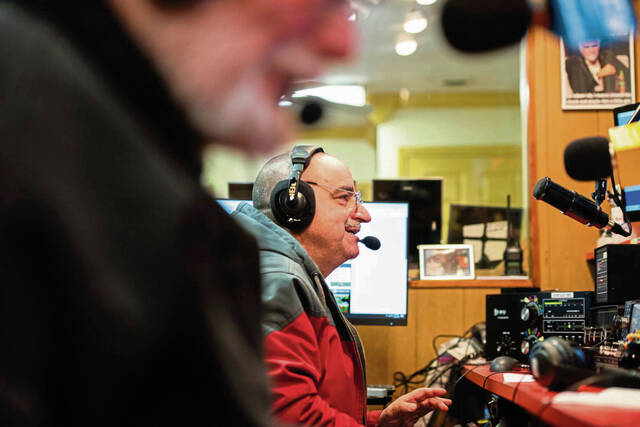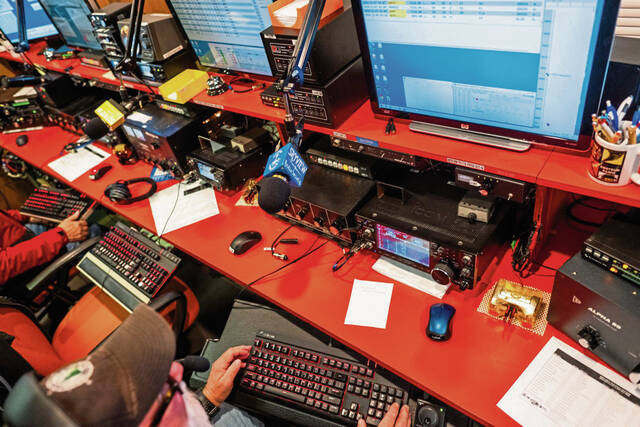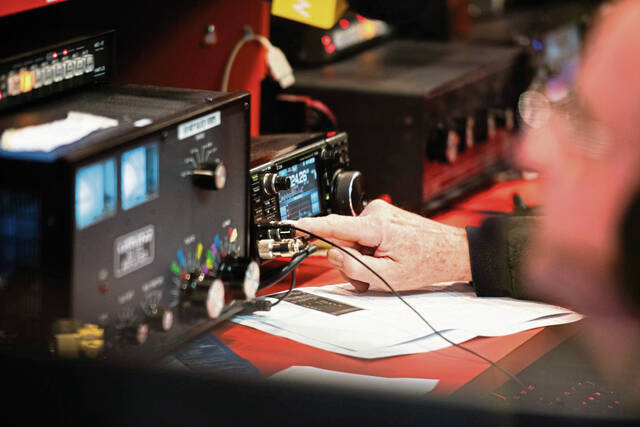‘To observe and report': Radio hams play key role for National Weather Service
Steve Fazekas and Eddie Misiewicz are self-proclaimed weather geeks and have the stories to prove it.
In 1977, Misiewicz, then a volunteer firefighter in Dawson, Fayette County, went to Johnstown to respond to the devastation from a flood. He remembered picking bodies out of trees.
Fazekas, of Winfield, recalled the tornado outbreak of 1985, while he was camping in Burrell Township. There were about 18 or 19 tornadoes confirmed in the area with fatalities in the Saxonburg area.
They both remember the historic Blizzard of 1993. Hurricane Ivan followed in 2004.
“My little village — Leasureville — made the Weather Channel,” Fazekas said. “The flooding was epic in my area.”
And Misiewicz got his shot on TV in 2010 with NBC’s Al Roker when a massive snowstorm led to a roof collapse at the Rostraver Ice Garden.
The experiences were part of the National Weather Service’s Skywarn storm spotter program, where roughly 350,000 to 400,000 trained volunteers aim to keep their communities safe by providing timely and accurate reports of severe storms to the weather service.
Fazekas and Misiewicz, both amateur radio operators, or hams, with the Skyview Radio Society in Upper Burrell, were two of many recognized by the weather service during its 25th annual Skywarn Recognition Day, which began Friday night and continued through most of Saturday.
“Hams have been part of Skywarn since its inception in the ’60s,” said Chris Maier, meteorologist for the National Weather Service.
“If we ever have a really bad day where all communication infrastructure goes down, amateur radio might be the only way to communicate. It’s another means for emergency communications to take place.”
What is Skywarn?
Misiewicz, 67, of Belle Vernon has been involved in Skywarn for 52 years. He serves as the Skywarn Amateur Radio Operations coordinator for the weather service’s Pittsburgh warning area. Fazekas, also 67, serves as the group’s assistant coordinator.
Skywarn’s mission is “to observe and report.” Spotters are not storm chasers, Fazekas said.
“We observe and report from wherever we are. We’re the boots on the ground for the weather service,” he said.
Reports are made by direct contact with the weather service’s local field office in Moon Township, phone apps or via amateur radio.
Hams also provide communication between the weather service and emergency management personnel if normal communications become inoperative.
“That helps us better warn the public of the elements that are out there,” Maier said.
Skywarn storm spotters also give back to the community, Fazekas said.
When a severe storm hits, homeowners who sustain property damage make a claim to their insurance company. The insurance company then verifies the severity of the storm with the weather service — which uses information provided to them from Skywarn storm spotters.
The storm spotters also provide information to emergency management departments, which then can relay the information to higher authorities should they need to declare a state of emergency or reassess plans after an event.
“We care about our local communities and how we can be of service,” Fazekas said. “Someday, I might be the guy that needs help. It’s a service to the community. For me, it’s a way to keep an eye on things and help people.”
To train for Skywarn, people must take a class through the weather service and pass an exam. They also can take an advanced class to learn more about weather dynamics such as radar and severe storm foundations.
“You can have severe weather in the summer and winter, but the dynamics are different and the effects of that weather will vary,” Fazekas said.
Hams are one-third of all Skywarn spotters
Skywarn and amateur radio still hold steady even with rapid advancements in technology. About one-third of all Skywarn storm spotters are hams, Maier said.
“Technology and nature are not good bedfellows,” Fazekas said. “You can have sophisticated technology, but Mother Nature does what she wants.”
Sometimes, forecasts can predict one thing and nothing happens, or vice versa. Fazekas says that’s not the fault of meteorologists.
“(Meteorologists are) far more right than you realize,” he said.
In recent months, the 35-county Pittsburgh region has seen some unusual weather.
Twenty-five tornadoes were reported in the Pittsburgh area last year, and there have been 19 this year. That’s a notable increase for the coverage area, which has averaged about six tornadoes annually since 1995.
“When there was the thundersnow, we joked, ‘Where’s Jimmy Cantore?’ ” Misiewicz said. “We got a lot of reports.”
Cantore, a popular on-air meteorologist for The Weather Channel, is known for his live reporting in bad weather.
With towers and lines above Turkey Ridge Road, the Skyview Radio Society’s clubhouse in Upper Burrell has capabilities to reach anywhere in the world, Fazekas said. Its call letters are K3MJW.
Be weather ready
Fazekas and Misiewicz stress the importance of people being educated about the weather.
“Weather can have the biggest impact on your day, more than anything else in this area,” Fazekas said. “Being ‘weather aware’ is a big deal.”
They both oversee 35 counties in Pittsburgh’s “coordinated warning area.” Each county has trained Skywarn operators, and that number seems to be increasing, Fazekas said.
“We’re seeing a nice growth in the Pittsburgh coordinated warning area,” Fazekas said. “It hasn’t been meteoric, but steady growth is what we’re looking at.”
In addition to Skywarn, they also participate in the Community Collaborative Rain, Hail and Snow Network — CoCoRaHS, for short — to help measure and report precipitation to the weather service.
“What we provide, report-wise, shores up the facts that you need to pay attention to what’s going on,” Fazekas said.
Maier agreed.
“It’s important to be prepared for understanding different severe weather phenomena that can impact your area,” he said.
Roughly 170 members are in the Skyview Radio Society, with its main core from the Alle-Kiski Valley. Members include doctors, lawyers and engineers.
The enjoyment is evident when Fazekas, an amateur radio enthusiast since he was 13, steps into the booth and puts on a headset.
“It’s a hobby you’re never done with,” he said. “This hobby has absolutely something for everyone.”
Kellen Stepler is a TribLive reporter covering the Allegheny Valley and Burrell school districts and surrounding areas. He joined the Trib in April 2023. He can be reached at kstepler@triblive.com.
Remove the ads from your TribLIVE reading experience but still support the journalists who create the content with TribLIVE Ad-Free.







